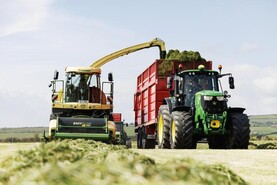Following success with last year’s crop, Footprint Farmer Barry Powell decided to sow a further 10 acres of a red clover silage sward last week.
Last year, he made some baled red clover silage, which he fed to freshly calved cows, as he found it boosted their intakes.
Some 15 acres was sown the previous year. The first two cuts went into the pit with main crop silage, while the third was baled.
A further 13 acres was sown last year after second-cut silage and this was grazed with in-calf heifers in the autumn.
Suitability
While red clover has a poor persistency in comparison to white clover, due to its growth habit, it suits silage-focused swards.
Under good management, it can persist at good levels for three or four years. In addition to this, the root structure is also deeper than white clover through a tap root, which gives it better drought tolerance in dry summers.
Sowing a silage mix with red clover included will suit silage fields, as it lowers chemical N costs, can increase intake and performance and also reduces greenhouse gas and ammonia emissions.
Three-cut system
The red clover sward is most suited to three-cut silage systems such as Barry’s, with the first cut taken in mid-May, with one grazing in the autumn.
Clover is sensitive to chemical N, so the areas that it is applied to will likely see a decline in the clover level. It is also a more challenging crop to ensile, especially if there is a high clover content in the sward.
When making red clover silage, the crop will typically require a 24- to 48-hour wilt in dry conditions. Over-wilting of the crop leads to leaf shatter issues.
Sheep systems
It is important to note that for sheep farms, red clover swards can cause issues with conception rates in sheep, as the plant contains amounts of phyto-oestrogens. Because of this, it is recommended not to graze six weeks either side of mating.
However, as mentioned above, silage intakes in cattle being fed red clover silage will be higher, which can increase performance.
High-red clover swards are also usually managed using little to no nitrogen fertiliser once growth kicks off.
It is also important to note that where animals are grazing swards containing a high percentage of red clover, that precautions are taken for bloat.






 This is a subscriber-only article
This is a subscriber-only article











SHARING OPTIONS: